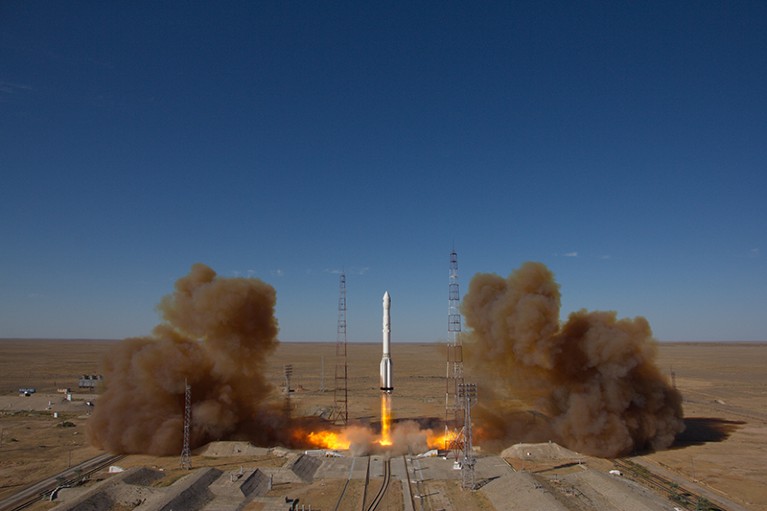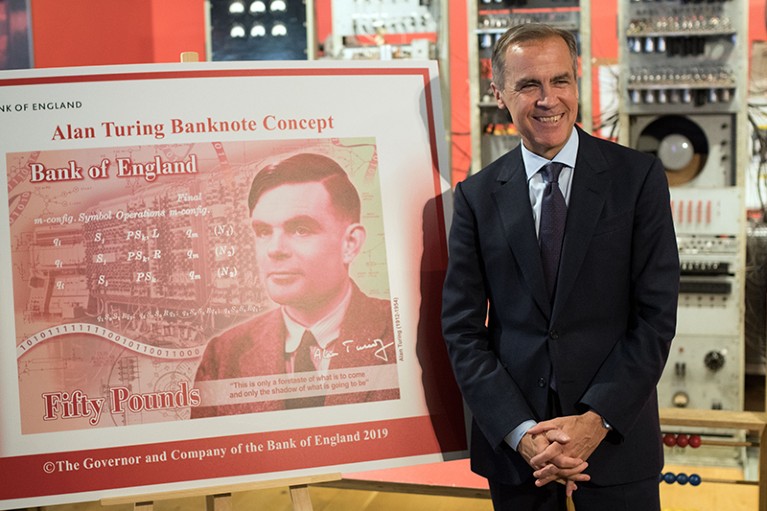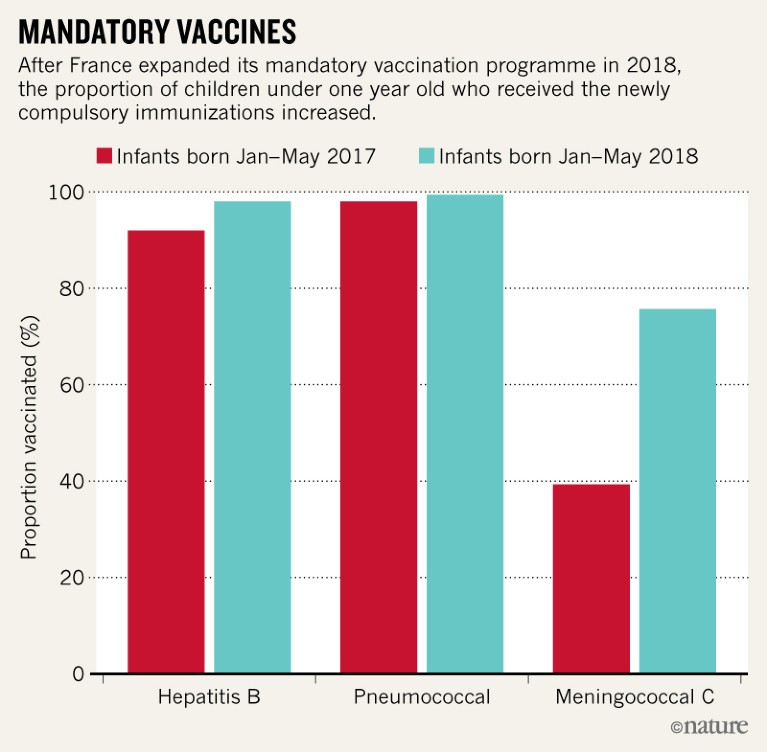SPACE
X-ray space telescope blasts off A German–Russian space telescope that will produce the first full-sky maps in high-energy X-rays has left Earth. Spectrum-Roentgen-Gamma (SRG) lifted off on a Russian-built Proton-M rocket on 13 July from the Baikonur Cosmodrome in Kazakhstan. It is now on a 100-day journey to L2, the second Lagrangian point, a gravitationally stable parking spot that trails Earth’s orbit around the Sun. From there, SRG’s two on-board telescopes — one built by a Russian team and the other by a German one — will chart maps of the Universe’s ‘hard’ X-rays, which have energies of up to about 30 kiloelectronvolts. It is expected to detect up to 100,000 galactic clusters, 3 million supermassive black holes and X-rays from as many as 700,000 stars in the Milky Way. SRG’s main scientific goal is to investigate the nature of dark energy, the mysterious force that is accelerating the Universe’s expansion.

A German–Russian X-ray telescope launched into space on 13 July from Kazakhstan on a Russian Proton rocket.Credit: Roscosmos
Mission aborted India’s space agency scrapped the launch of its second Moon mission 56 minutes before scheduled lift-off on 15 July because of a technical hitch with its rocket’s engine. The Chandrayaan-2 spacecraft will head for the Moon’s south pole, and India hopes that it will become its first mission to land on the lunar surface. The spacecraft is equipped with 14 instruments — 13 Indian and one from NASA — and aims to study the Moon’s rocks, soil, minerals and atmosphere, and to detect water. The craft was set to launch on India’s Geosynchronous Satellite Launch Vehicle Mark III. Engineers had filled the rocket’s cryogenic engine with fuel, but postponed the launch as a precautionary measure after detecting a leak. The Indian Space Research Organisation (ISRO) said that it might announce a new launch time after analysing the rocket. Chandrayaan-2 comes 11 years after India’s maiden lunar mission in 2008, which orbited the Moon. ISRO announced plans for Chandrayaan-2 in 2008. Russia pulled out of a planned collaboration on the spacecraft in 2013.
FACILITIES
Stem-cell agency The California Institute for Regenerative Medicine (CIRM) in Oakland has run out of money for new projects and will no longer accept grant applications. CIRM was created in 2004 after California voters approved a ballot initiative that provided US$3 billion for stem-cell research. Over the past 15 years, CIRM has funded more than 1,000 research projects, including 55 clinical trials. But that money has dried up. The agency has just $33 million left for new grants, yet it is evaluating a backlog of applications that would cost $88 million. The 260 or so projects that CIRM already funds will continue as planned, but its dwindling coffers cast doubt over the future of stem-cell research in California. The advocacy group Americans for Cures, founded by CIRM supporters, is considering spearheading a 2020 ballot initiative to provide $5.5 billion for the struggling agency, but has not announced concrete plans.
Telescope project An attempt to restart construction of the controversial Thirty Meter Telescope (TMT) in Hawaii is being delayed by protests. Previous protests and legal challenges had postponed the TMT team’s plans to build atop Mauna Kea, a mountain sacred to Native Hawaiians, over the past four years. On 10 July, Hawaii governor David Ige said that construction would restart on 15 July — prompting another round of protests. TMT officials had estimated the project’s cost to be US$1.4 billion, but that ffigure has almost certainly risen since April 2015, when protests halted the first attempt to build the telescope. The Hawaii supreme court revoked the TMT’s construction permit later that year, sending the project to Hawaii’s Board of Land and Natural Resources to undergo a second permit process. Last October, the court ruled that the telescope’s second permit was valid.
PEOPLE
Turing honoured Mathematician Alan Turing will adorn the Bank of England’s new £50 note, beating physicist Stephen Hawking and a legion of other renowned scientists considered for the honour, the bank announced on 15 July. Turing is considered the founder of computer science and a national hero, having helped to crack the code of German encryption machines during the Second World War. Turing was gay, and was convicted for gross indecency in the 1950s. He died in 1954, aged 41, and was pardoned by the Queen in 2013. In 2018, the bank called on the public to suggest scientists who could appear on a redesigned £50 note, and received nominations for 989 eligible individuals. A committee shortlisted 12, and the bank’s governor, Mark Carney (pictured), made the final decision. Palaeontologist Mary Anning, crystallographer Rosalind Franklin and mathematician Srinivasa Ramanujan were among the contenders.

Bank of England governor Mark Carney selected Alan Turing to appear on a new £50 banknote, which also features the mathematician’s birth date written in binary code.Credit: Oli Scarff/Getty
EVENTS
Ebola outbreak The Ebola outbreak in the Democratic Republic of the Congo (DRC) has spread to Goma, one of the country’s biggest cities. On 14 July, the DRC health ministry said that an evangelical pastor had been diagnosed with the disease at a treatment centre there. The pastor had preached in Butembo, a hotspot of the outbreak, where he laid hands on people who were ill. After he began to feel sick, he travelled to Goma by bus — a two-day journey. Doctors there transferred him to an Ebola treatment centre. The ministry has given an Ebola vaccine to all passengers on the bus and will monitor them for 21 days. It says that the risk of Ebola spreading in Goma is low because the pastor was diagnosed quickly. Ebola has killed an estimated 1,665 people since 1 August 2018, according to the DRC health ministry.
Satnav troubles Galileo, the European Union’s global satellite-navigation system, has experienced a continuous service outage since 11 July. The navigation and timekeeping services that it offers users worldwide had not been restored as Nature went to press. Galileo officials said that a technical issue in its ground infrastructure — the cause of which has been identified — is behind the outage, but released few further details. The ground-tracking network is a crucial part of the satnav system, and uploads orbit corrections to the 26 Galileo satellites in near real-time. Galileo began offering services in 2016. A 15 July statement on the Galileo website emphasized that the system is still in the pilot phase, which is designed to detect technical issues before it becomes fully operational next year.
RESEARCH
Mosquito success A trial to control the Asian tiger mosquito (Aedes albopictus), the world’s most invasive mosquito species, has nearly eradicated the insects from two sites in Guangzhou, China. For the first time, researchers field-tested a combination of two techniques that have been used separately in previous mosquito elimination trials. The two-pronged approach involves infecting males with a strain of Wolbachia bacteria, hindering the insects’ ability to transmit disease-causing viruses such as dengue and Zika, and preventing them from producing offspring with females without the same strain. Researchers then gave the female mosquitoes low-dose radiation to sterilize them. After the researchers released millions of the mosquitoes in 2016 and 2017, the overall number of wild adult mosquitoes at the two test sites decreased by up to 94% each year. The researchers published their results on 17 July (X. Zheng et al. Nature https://doi.org/10.1038/s41586-019-1407-9; 2019).
TREND WATCH
Vaccination coverage in France and Italy has increased following the expansion of mandatory vaccination laws, according to two analyses. Both countries already required children to receive diphtheria, tetanus and polio vaccinations. Italy also mandated immunization against hepatitis B. France — home to one of the highest rates of vaccine mistrust in Europe — made eight more vaccines mandatory for babies born from 2018 onwards, including vaccines against hepatitis B, pneumococcal and meningococcal C diseases.
A preliminary analysis of the French law’s impact found that rates of these vaccinations were higher among babies born in the first five months of 2018 than among those born in the same period in the previous year.
Italy made another six vaccines mandatory in July 2017 after a large outbreak of measles that affected more than 4,000 Italians. The second paper found that coverage of these immunizations increased: in 2016, 87% of 2-year-olds were vaccinated against measles, but by mid-2018, that number had risen to 94% among 30-month-old children. The studies were published in June in Eurosurveillance.

Source: D. Lévy-Bruhl et al. Euro Surveillance 24, 1900301 (2019).



